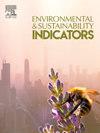北阿坎德邦基于机器学习和gis的多灾害风险建模:整合地震、滑坡和洪水易感性与社会经济脆弱性
IF 5.4
Q1 ENVIRONMENTAL SCIENCES
引用次数: 0
摘要
多灾害风险(MHR)的复杂性日益增加,需要全面了解多种自然和人为危害是如何相互作用的。这些可能在脆弱地区同时或依次发生,潜在地扩大其影响。北阿坎德邦位于印度喜马拉雅地区,由于地形、气象、水文、社会经济和环境因素,极易发生MHR。本研究提出了北阿坎德邦的区级MHR评估,将地震、滑坡和洪水易感性与社会经济(即人口密度、弱势人口、识字率和就业率)和建筑环境(即建筑密度和道路密度)易感性相结合。利用机器学习算法生成个体危险图并叠加成多危险易感性图,再将多危险易感性图重新分类为多危险指数(MHI)。利用层次分析法(AHP)对脆弱性指数(VI)进行量化,并综合MHI和VI计算多灾害风险指数(MHRI)。北阿坎德邦约21.01%的总面积同时面临地震和滑坡风险,其中22.36%被列为高至极高MHR区。Tehri Garhwal和Rudraprayag地区被确定为高度脆弱和容易受到多重灾害风险的影响。与传统的单一灾害评估不同,本研究全面评估了重叠危险区,以了解多灾害动态。这些发现为减少灾害风险提供了重要见解,为经济规划、风险融资和土地利用规划战略提供了信息,以增强北阿坎德邦基础设施和社区的复原力。本文章由计算机程序翻译,如有差异,请以英文原文为准。
Machine learning and GIS-based multi-hazard risk modeling for Uttarakhand: Integrating seismic, landslide, and flood susceptibility with socioeconomic vulnerability
The increasing complexity of multi-hazard risk (MHR) demands a comprehensive understanding of how multiple natural and human-induced hazards interact. These can occur simultaneously or sequentially within a vulnerable region, potentially amplifying their impacts. Uttarakhand, situated in the Indian Himalayan region, is highly prone to MHR due to topographical, meteorological, hydrological, socio-economic, and environmental factors. This study presents a district-level MHR assessment for Uttarakhand, integrating seismic, landslide, and flood susceptibilities with socio-economic (i.e., population density, vulnerable population, literacy rate, and employment rate) and built environment (i.e., building density and road density) vulnerabilities. Employing machine learning algorithms, individual hazard maps are generated and overlaid to prepare multi-hazard susceptibility maps, which are further reclassified into multi-hazard index (MHI). The vulnerability index (VI) was quantified using the Analytical Hierarchy Process (AHP), and the multi-hazard risk index (MHRI) was subsequently calculated by integrating MHI and VI. About 21.01 % of the total area of Uttarakhand faces simultaneous risks from earthquakes and landslides, with 22.36 % classified as being in high to very high MHR zones. Tehri Garhwal and Rudraprayag districts are identified as highly vulnerable and susceptible to multi-hazard risk. Unlike traditional single-hazard assessments, the present study comprehensively assesses overlapping hazard zones to understand multi-hazard dynamics. These findings offer critical insights for disaster risk reduction, informing strategies for economic planning, risk financing, and land-use planning to enhance the resilience of infrastructure and communities in Uttarakhand.
求助全文
通过发布文献求助,成功后即可免费获取论文全文。
去求助
来源期刊

Environmental and Sustainability Indicators
Environmental Science-Environmental Science (miscellaneous)
CiteScore
7.80
自引率
2.30%
发文量
49
审稿时长
57 days
 求助内容:
求助内容: 应助结果提醒方式:
应助结果提醒方式:


